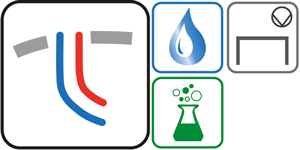Klaipėda, Lithuania
DESTRESS stopped its research activities in Klaipeda in 2017.
The Klaipėda Geothermal Demonstration Plant is a geothermal heating plant in Klaipėda, Lithuania, constructed during the late 1990s and early 2000s. It was the first geothermal heating plant in the Baltic Sea region. The plant uses 38 °C water from two wells drilled into a Devonian aquifer about 1 100 meters beneath the surface. Additional two wells are used to re-inject the cooled water into the aquifer again. The heat is extracted using absorption heat pumps. Then it is contributed to the existing district heating system. Geothermal water circulates in a closed loop. During its exploitation, difficulties arose when gypsum precipitations clogged the tubes of the surface loop and absorption heat pumps heat exchanger’s tubing, but these problems were overcome, and in 2004 the State Commission confirmed a plant capacity of 35 MWt, of which geothermal constituted 13.6 MWth. 103 000 MWh of heat were produced in 2001, increasing to 215 000 MWh in 2003. Enterprise GTL experienced financial difficulties, coming close to bankruptcy in 2007. Short time solutions were found with the results that the operation could go on. However, in the meantime a continuous decrease of injectivity was observed which requires EGS methods to reinstall the former performance and to establish a sustainable geothermal system.
| Operator |

|
|---|---|
| Work Package No | 4 |
| Location | Klaipėda, Lithuania |
| Construction Year | 4 wells since late 1990s |
| Foreseen Stimulation Techniques |

Optional drilling radials, cleaning, cross flow, and stimulation techniques: Acid (HCL and/or HCL-HF) |
| Type of Use | District Heating system |
| Soil Condition | Clastic rocks (SS) of the low-enthalpy geothermal resources |
| Production Horizon | Lower Devonian (Viesvile formation) |
| Upper Depth (m) | 990 |
| Thickness (m) | 128 |
| T (°C) | 38 |
| Salinity (g/l) | 108 |
| Contact | Sigitas Petrauskas, Director Phone: +37 046326163 |




